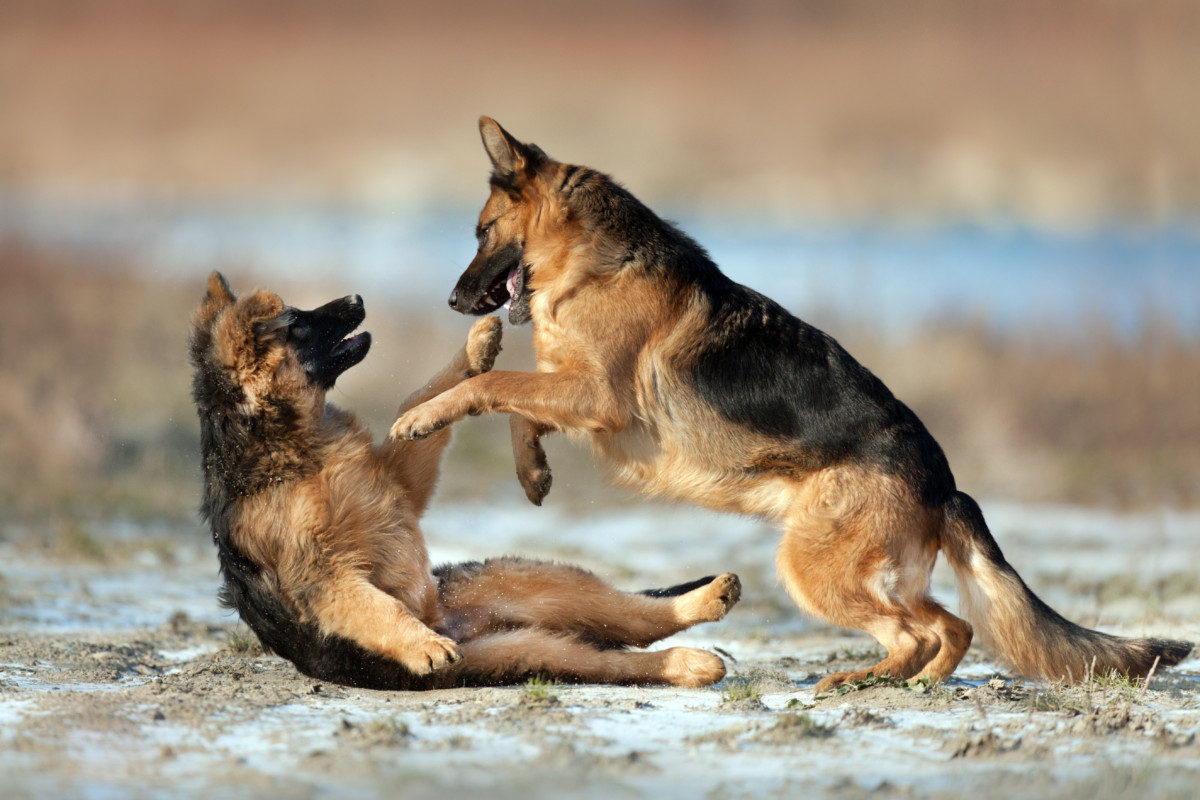German Shepherds are an intelligent breed known to be loyal and loving to their owners. Female GSDs are extremely popular, and their caring nature can often cause owners to want a second dog in their home.
When it comes to having two female German Shepherds, you always want to have ones that will get along.
Two female German Shepherds can get along; however, the German Shepherd breed is known to develop same-gender aggression. Two females in the same home often show aggression toward each other. This aggression can be dangerous and may result in one of the dogs needing to be rehomed.
Female German Shepherds have several excellent characteristics, but placing two together often results in misbehavior and fighting. However, you can prevent this with socialization, training, and early intervention.
Read on to discover why female German Shepherds may have difficulty getting along and what you can do about it, especially if you have your heart set on another female GSD.

Female German Shepherds and Same-Gender Aggression
It can be surprising to hear about female-to-female aggression when female German Shepherds have such calm, gentle mannerisms and are very friendly towards their families and others.
However, any dog breed, male or female, can show aggression. So why do female German Shepherds have such difficulty having another female around?
Two females living together can feel pressured to show dominance in the family or pack.
The need to assert themselves and show who the boss is can lead to major conflict and deadly fights:
Female aggression can also develop later in life. If you bring home two female puppies, they may get along at first but then become aggressive toward one another.
Here are a few things that can trigger aggressive behavior in females:
- Going into heat.
- Hormones and pheromones.
- Breeding rights with a male or having a male around.
- Whoever gets first to greet the owner or someone else.
- Fights over toys, food, or attention.
- Rights to privileged areas such as beds, lounging areas, doorways, food bowls, etc.
Females closer in age can have even more problems with aggression than females of different ages. This is because they are similar in rank to each other. A female dog naturally wants to be the only dominant female of the “pack.”
If another female dog of similar age is present, it can create more issues than if the other female dog were much younger. However, older females can still show hostility towards younger ones, so you must be careful.
Contrary to many claims, getting female German Shepherds spayed has not been proven to help reduce aggressive behavior.

One of the most extensive studies of almost 11,000 dogs proved that spayed and neutered dogs actually show considerably more aggression. You can find the full study here.
The best thing to do when you have two female German Shepherds who will not get along is to contact a canine behaviorist to resolve the problem.
A dog behaviorist is a qualified professional with expert knowledge of dog behavior and communication and will formulate a plan to work with you.
The Animal Behavior Society provides a helpful directory of Certified Applied Animal Behaviorists.
If all else fails, you can consider rehoming one of them; however, this will be a heartbreaking decision and probably the last thing you want to do.
If you do not want to part with either dog, you must keep them separated, especially when unattended.
Related: How to Train an Aggressive Female German Shepherd.

Can Two Female German Shepherds Get Along?
If you are set on having two female German Shepherds living together, there are a few things you can do to try to help them get along.
However, throughout the process, remember that it isn’t your fault if the methods do not work. Some female German Shepherds have a strong enough desire for dominance that they’ll never settle for letting another female dog live with them.
Here are a few steps to follow:
- Evaluate your current dog – If you are still considering adding a second female German Shepherd to your home, you will want to evaluate your current female German Shepherd. Think how she might handle having a second dog in the family. Think about your dog’s personality, behavior history, and training ability. If she already shows signs of aggression or has difficulty following commands or with training, it might not be a good idea to bring another dog into her life.
- Picking the dog – If you feel your female German Shepherd will do well with another female companion, the next step is selecting your second dog. Try to find a socialized German Shepherd with a similar personality to your current female. If you have an outgoing, energetic dog, look for an outgoing and energetic puppy. Talking to the breeder about each dog’s personality can help you select one that will match your dog’s temperament. To help you with this, check out my complete buyer’s guide on how to buy a German Shepherd.
- Location for introducing the dogs – Do not do it at home when introducing your dogs. If you try to introduce them at home, your current dog may feel the need to protect her property and show her dominance. Select a neutral location so they are less likely to view each other as intruders.
- How to introduce the dogs – Once you have selected a location for them to meet, ensure each dog is wearing a sturdy collar and leash. You also want each dog to be accompanied by a human they respect and listen to.
- Use Positive Reinforcement – You want the meeting experience for each dog to be as positive as possible right from the start. Let the dogs sniff and greet each other as usual when they first come in contact. During this time, calmly and positively encourage each dog verbally.
After a few minutes, command each one to sit or lay down. This will give them a break from each other. After the short break, allow them to explore one another once again. As things progress positively, you can start walking them or doing other controlled activities together that allow them to become familiar with each other.
- Look for negative body posture – If either dog shows signs of negative body posture while interacting, divert their attention back to you by giving some commands. One example of this is if your German Shepherd’s hair stands up. Use positive reinforcement to keep your dog calm and know everything is safe. Once the mood has changed, let the dogs interact once again.
- Bringing them home – As soon as the dogs are comfortable with each other in a neutral location, you can bring them home. Keep them in a separate car when bringing them home unless you feel they are ready to share a car. Once you arrive, allow the newer dog to enter the house first. This will minimize any territorial issues that your older dog may have.
- Feeding and treats – Dogs can become very protective of their food, so ensure you always give each dog her bowl of food. Having them each eat in their crates at the start is also a good idea. The same thing goes for treats and bones. Ensure each dog is treated or has her bone to chew on. Never let the dogs eat near each other unsupervised.
Learn How To Introduce Two Dogs In This Video…
You will always want to observe your dogs as they grow older to ensure they continue to show positive behavior toward one another.
It is never a good idea to leave them unattended at any age. Female German Shepherds, as mentioned earlier, can become aggressive toward one another later in life.
Of course, you can leave them in their own crates for a while. To learn more about how long you can leave a German Shepherd in a crate, this post gives a ton of detail, including the best crate size to use and other helpful tips.

Two Female GSDs: How to Foster Friendship
Introducing two female German Shepherds to each other is easier than maintaining them in the long run, thereby controlling aggression and ensuring harmony.
If you’ve two female German Shepherds at home, here are a few ways to control aggression and help them get along.
- Follow positive reinforcement and offer them toys or treats each time they’ve had a happy interaction.
- Allow them to understand each other, taking as much time as necessary. Intervening in the middle and worrying about aggression can discourage them from getting along.
- Training needs a longer duration than usual. Since they’re prone to same-gender aggression, training them individually and also together will help them understand commands and respond better.
- Spend time with them together. Spending time with one female GSD over the other can also provoke the other one to turn aggressive. Cuddling and playing with them simultaneously will promote positives in them.
While having two female German Shepherds isn’t as complex as assumed to be, it needs adequate effort from the owner’s end to ensure a smooth atmosphere.
Take extra caution in building relationships with them, as GSDs are specific about their masters. Be patient throughout the process, and you can eventually get there.
Male vs. Female GSDs: Finding the Best Pairing for Harmony
If you want to have two same-sexed German Shepherds, consider having two males over two females. Although male German Shepherds can also show aggression towards each other, it tends to be less severe than female aggression.
When two males are together, they often fight over domestic dominance. They will typically try to prove their dominance by marking territory, making noise, showing off, etc.
Often, an older male German Shepherd will express dominance, and the younger one will submit and accept that dominance. If this is the case, there tends to be little aggression.
Females, on the other hand, will fight over breathing rights. Female fights are much more severe and tense than male dog fights and can often end up with one of the dogs badly hurt or even killed.
Female-on-female aggression tends to be more dangerous than male-on-male.
The best thing to do if you want to have two German Shepherds get along is to have one male and one female. With a dog of each gender, you are less likely to run into aggression and behavioral issues caused by dominance or territorial issues.
Final Thoughts
Having two female German Shepherds get along is uncommon but not impossible. Use the suggestions in this article to guide you as you work with your dogs and teach them that they can accept and get along well with each other.
Related Posts You May Like:





